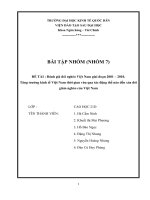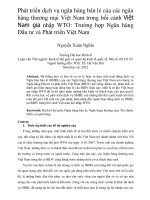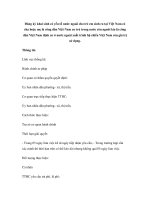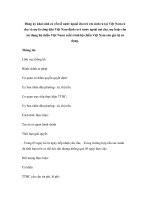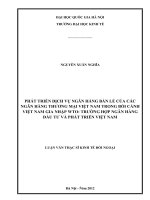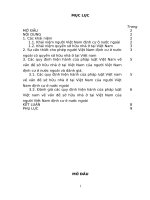Sốc văn hóa giữa Anh và Việt Nam
Bạn đang xem bản rút gọn của tài liệu. Xem và tải ngay bản đầy đủ của tài liệu tại đây (94.41 KB, 14 trang )
… UNIVERSITY
…
ASSIGNMENT ON
CROSS-CULTURAL COMMUNICATION
TOPIC: CULTURE SHOCK
Lecturer:
Student:
Class:
GUARANTEE
*****
“I hereby declare that this thesis is my own work. The data and research
results in the essay are honest and have never been published in any other work.
I also hereby declare that any help has been received in the preparation of
this thesis and that the sources cited in this thesis have been acknowledged.”
Author
TABLE OF CONTENT
Page
I. INTRODUCTION...................................................................................................................4
II. CONTENT.............................................................................................................................4
1. Definition of culture shock..............................................................................................4
2. Times of culture shock.....................................................................................................5
2.1. The first period (from 1 to 2 months):.........................................................5
2.2. Phase 2 (about the next 3-6 months)...........................................................5
2.3. Stage 3 (about the next 6-12 months):.........................................................6
2.4. The “Self-Acceptance” Stage....................................................................6
3. The Mechanism of Culture Shock...................................................................................7
4. English-Vietnamese culture shock through language communication............................8
4.1. Culture shock when it comes to complimenting and receiving compliments..........8
4.2. Culture shock: how to choose the main point of communication................................9
4.3. Culture shock due to literally speaking/translating........................................10
4.4. Culture shock due to roundabout expression...............................................11
III. CONCLUSION...................................................................................................................13
REFERENCES.........................................................................................................................14
I. INTRODUCTION
Culture is the essence and spirit of each nation. The process of cultural
formation occurs at the same time as the processes of cultural contact, cultural
borrowing, cultural transformation, and cultural integration, especially the
phenomenon of interference between different cultures through children. different
ways, such as: war of aggression, trade exchange, or through various forms of
evangelism...
The concept of interculturality can be understood in two ways. That is the broad
sense and the narrow sense. Cultural interference is the process of cultural contact
between two ethnic groups. Interculturalism is the phenomenon of the influence of one
culture on another culture.
In Vietnam in the integration period, the process of cultural interference takes
place strongly, especially with English-speaking countries, the world's most popular
language. The English-Vietnamese cultural interference poses many problems,
including many difficulties that hinder the integration process, especially in the field of
communication. This has resulted in culture shock for English-speaking Vietnamese
and people in the English-speaking Vietnamese community. This is an issue worthy of
attention, requiring solutions to reduce negative interference and the phenomenon of
culture shock, stimulate integration, and create conditions for development in other
social fields.
II. CONTENT
1. Definition of culture shock
In the view of Claire Ellis, "culture shock is used to describe the wide and
varied range of emotions people can feel. It is a combination of psychological and
physical trauma that a person experiences when he or she enters a new environment.”
According to Jack C. Rechar, "culture shock is understood as feelings or strong
feelings of discomfort, fear, or insecurity that a person may experience when moving
to another country. other cultures. For example, when a person moves to a new culture,
4
they will experience a series of culture shocks until they actually become a member of
that new culture. "
Thus, culture shock is the phenomenon that occurs when a person of one culture
moves to live in another culture, where everything becomes foreign to the native
culture. At first, there is a feeling of confusion, surprise, and lack of understanding; the
latter may turn into a negative rather than hostile, confrontational attitude, especially
when the person refuses to use the new language. This kind of feeling occurs when
people feel threatened and unsafe because no one understands them and they don't
understand anything about this new culture.
Anyone can experience culture shock when moving to another culture. Each
country or ethnic group has its own culture. Moving to a new country entails adjusting
to everything, and culture shock occurs regardless of how much time you spend
preparing for it. However, the more careful preparation (especially the cultural
knowledge of the new land), the more the shock level will be reduced. That equates to
faster adaptation and integration time.
2. Times of culture shock
According to Esther Wanning, there are four specific periods of culture shock:
2.1. The first period (from 1 to 2 months):
The country, the people in the place you come to are very joyful, pleasant,
better than at home. Everything is very different and interesting, the people are
friendly; the customs are interesting.
2.2. Phase 2 (about the next 3-6 months)
When the initial excitement fades (wearing off), everyone looks selfish,
shallow, and stupid. Strange customs and manners don't seem to be interesting
anymore; it's all boring and seems to be working against you. You start to feel very
tired all the time. Culture shock forms. You are confused as to what you are doing
here. This reaction is not unusual because you are surrounded by people imbued with a
different culture, and you do not know how to do even the simplest things. Speaking
5
the local language, it is also impossible to understand the behavior of people. You feel
a great loss because your existing style is now not helping you to control the situation.
The emotional reactions to culture shock can be extreme: bewilderment, despair,
frustration, anxiety, irritation. even become physically ill. Even the smallest things can
make you angry, and feeling offended can make you cry. In this situation, many people
intend to move to live in the private areas of foreigners to find compatriots. Country
people can be a barrier for you to adjust to your new life. If they reinforce your
negative feelings about the people here, the more difficult it will be for you to get over
culture shock, especially if you don't use the new language often. The people here will
forever be strangers to you. Feelings of culture shock may decrease, but you still feel
uncomfortable and homesick.
2.3. Stage 3 (about the next 6-12 months):
These fellow countrymen tell you that in the past they felt the same way you do
now. Instead of analyzing what's wrong with the native language, they remind you that
the words "true" or "false" have no meaning in cultural matters. You should try to see
what motivates the person to do such a thing, and maybe you will get many of your
likes back. You can go find a native to ask about what you don't understand. Try to
keep your head clear, spend time learning about your new country, keep mixing
regimes, and you will see things get better. up. The most important thing is that you
should not be bored and stay at home. Go out and do what you like, especially keep
learning foreign languages.
2.4. The “Self-Acceptance” Stage
After about a year, you no longer think much of the strange things the natives
do. By feeling them as unique individuals, you will feel at home and know how to
behave in any situation. You find it interesting to be a person of two cultures. The
native culture is not rejected, but the second way of life begins to settle in a new place
for a long time.
6
3. The Mechanism of Culture Shock
Culture shock is operated by a complex mechanism both in terms of human
psychology and linguistic aspects. According to Dr. Nguyen Van Chien, the
components of culture shock as a mechanism include at least two identities: the shock
maker and the shock sufferer.
Shockers are communicators who have caused culture shock to others due to
their cultural differences. They often tend to impose behaviors that are stereotyped in
their native culture on behaviors in other cultures, or to do so in a culture different
from the one in which they exist for their own sake. lack of understanding of the very
culture in which they live and interact.
Shock sufferers are those who misinterpret cultural behaviors when they engage
in cross-cultural contact. This phenomenon is called "migration to an unfamiliar
culture." When an individual of culture A is trying to assimilate into culture B,
observing a phenomenon belonging to culture B at a certain distribution point, he
understands the same meaning as his cultural phenomenon. When he reversely applies
his behavior to the phenomenon of culture B, as he is used to the same phenomenon in
culture A, he receives different responses than when he behaves in culture B. A,
sometimes to the negative, he feels shocked.
In addition, there are two other important components: the psychological and
physiological traumas of the communicator as an end result of culture shock as a
process; and the causes (processes) leading to those traumas.
When one person engages in interlanguage communication, he or she can be
both a shocker and a shocker, alternating. As a result, the participants in the
communication can become hostile or confrontational with each other.
Culture shock is the result of the cultural interference phenomenon. Negative
interference is the premise of potential culture shock. There are two basic types of
culture shock: culture shock expressed through linguistic communication (through
7
different languages) and culture shock expressed through non-verbal communication
(sign language or communication sign systems).
4. English-Vietnamese culture shock through language communication
In English-Vietnamese interlanguage communication, culture shock often
occurs in some typical cases. In addition to the cases of cultural interference
mentioned above (potential forms of culture shock), there are also notable cases such
as: complimenting and receiving compliments, literal translation, roundabout
expressions , how to conduct a conversation, answering the phone... Below is a
specific study of these typical cases:
4.1. Culture shock when it comes to complimenting and receiving
compliments
Praise is a behavior that exists in all cultures and at all times. It is also a speech
act performed in all languages to serve many different purposes, such as: starting a
conversation; suggesting, enlisting affection; professing admiration; paving the way
for suggestions; asking; showing care; expressing gratitude, encouragement... Praise is
understood as expressing the positive evaluation of an individual, a group, or a
community; about an individual, a group, or a community; other or about something or
a certain event with satisfaction. Therefore, praise is a dynamic, diverse, and highly
subjective behavior.
The method of commendation is also very diverse and depends on many
subjective as well as objective factors such as: object of commendation, object of
commendation, subject of praise, purpose of commendation, circumstances of
commendation, and the relationship between the object of commendation and the
object of praise. Praise statue...
For example:
A Vietnamese girl is praised: "You've got a new beautiful dress!" (Your new
shirt is so beautiful.)
She replied back: "I don't think so!" It's old stuff. (I don't think so. It's old.)
8
Vietnamese people are very humble or have a habit of condescending when they
are complimented or denied. In contrast, Westerners love to be complimented and
often immediately respond to compliments with a thank you. The guy in this case
expected a thank you from the girl after being complimented by him. But the
Vietnamese girl, by applying a very Vietnamese way of thinking and acting, surprised
the boy. She immediately denied the beauty and newness of the dress out of her habit
of modesty, but left the young man wondering about his ability to judge.
Cultural researcher Barbara Cohen commented: "Vietnamese people are very
modest, especially in communication. But sometimes that modesty is so outrageous
that Westerners don't understand why. " For that attitude, Westerners often ascribe:
"Vietnamese people are not real."
4.2. Culture shock: how to choose the main point of communication
Choosing the topic of communication is an important step that directly affects
the progress of the conversation. Cultural differences in how to choose communication
topics are one of the reasons why the communication process is delayed or broken'
right after one or two words are said. Here are some typical shocking cases for
foreigners that Vietnamese people often encounter.
For example:
A conversation between a Vietnamese (A) and an Englishman (B) who have just
met for the first time.
A: - Hi!
B: - Hi!
A: - How many children have got? (How many children do you have?)
B: - Do you really want to know that? (Do you really want to know?)
A: - Yes, I do. (Right)
B: - What for? (What do you do?)
A: (Embarrassed).
9
In internal communication, Vietnamese people have the habit of talking to each
other about private matters in public places. Most gift stories touch on personal issues.
British culture is the opposite. Private things are considered taboo in social
communication, especially when a woman meets for the first time her age, husband
and children... it is very impolite. In the above meeting, the Vietnamese deliberately
developed the conversation topic according to their cultural habits. The British avoided
answering because they thought that Vietnamese people poked into private lives with
interrogation questions, and eventually the conversation was deadlocked.
4.3. Culture shock due to literally speaking/translating
In the process of learning foreign languages, learners often have the habit of
translating their ideas literally from their mother tongue to communicate in a foreign
language. From the perspective of language-culture interference, this is a form of
borrowing both the language and culture of the mother tongue. Because they already
know their mother tongue plus the available cultural knowledge, learners mistakenly
believe that with their knowledge of grammar, vocabulary, and phonetics of a foreign
language, they will be able to express exactly what they want to say. for native
speakers. But in reality, this borrowing both does not produce the desired effect and
shocks native speakers because they do not understand what the interlocutor wants to
say. The most common error in this error is the phenomenon of word-for-word
translation of idioms, proverbs, idioms... in the native culture into the target culture
without knowing that the target culture exists in the target culture. Those words are not
Usually, the way of saying it will be different because these terms are formed on the
basis of the social characteristics, production, concepts, etc. of each ethnic group. Here
are some typical cases in Vietnamese discourse that cause confusion for English
speakers.
For example:
The Vietnamese say: "The road is in front of me." Similarly, this Vietnamese
has arbitrarily translated the expression "sugar in the mouth" from Vietnamese into
English without bothering to find the equivalent sentence. English speakers will be
10
surprised at this sentence because they do not understand it. To express this, English
would be: "You have to ask for the wav".
In the above cases, because the learners' communication capacity is still limited,
if they want to use fixed phrases, they do not hesitate to include their language
knowledge, thinking ability, and existing cultural capital. using one's mother tongue to
achieve one's own communication purpose, thus causing ambiguity in the target
language due to incompatibility with the target culture. Fixed languages can be
considered the most difficult to access area in learning foreign languages and cultures
because these are all learned experiences associated with the culture of each ethnic
group. You must be really fluent in the language and culture of that nation to be able to
skillfully and appropriately use fixed languages in communication like a native.
4.4. Culture shock due to roundabout expression
Gossip is a strategy used in interlingual communication, which is not a
communication error in itself. But this is one of the causes of errors in learners,
shocking the recipients of the message. It causes the process of interlanguage
communication to be interrupted or broken when the speaker and the listener do not
understand each other. Due to limited language ability and not seeing the very
important role of cultural factors in the communication process, listeners self-imposed
linguistic-cultural habits of their mother tongue while looking for ways to express
themselves. They achieve a roundabout that they consider to be equivalent, leading to
misunderstandings and misunderstandings in communication.
In interlanguage communication, the speaker does not know the words or
sentence patterns that need to be used immediately, so he cannot express his thoughts
directly, but must interpret in a roundabout way by using combinations of words or
structures that they consider to have the same or nearly equivalent meaning. In intraverbal communication, because there is context, roundabout expressions can
sometimes still be effective. But in intercultural communication, when cultural factors
are outside the universal or local scope of influence, misunderstandings and
misunderstandings often occur. because what the speaker/writer wants to express
11
cannot be decoded by the listener/reader. Consider the following two cases to see how
shocking roundabouts can be.
12
III. CONCLUSION
Through the study of some typical cases, it can be seen that national cultural
characteristics are the cause of cross-cultural errors—the main cause of culture shock
in intercultural communication. The phenomenon of shock can still exist even when
the language proficiency and ability of the learners are quite complete because the
cross-cultural errors prove to be the most difficult to overcome. Existing culture shock
shows the limitations of common language ability, common thinking ability, and lack
of cultural and social knowledge about the target language. This is a remarkable thing
in foreign language teaching and learning activities in order to find ways to overcome
interference and minimize the behaviors that cause culture shock when communicating
with people from the language community that they are studying. This can also be
considered as the ultimate goal of the process of teaching and learning foreign
languages in general, and English in particular.
Culture shock in intercultural language communication are relatively new
issues, and due to the limited time and scope of research, this work inevitably has
limitations and shortcomings, such as: unable to mention all the cases that cause
interference and culture shock in reality, limited in actual survey and statistics related
to specific data, collected cultural situations and puzzles are limited. These existing
issues suggest a broader research direction in higher-level works in the future, with the
goal of overcoming and reducing culture shock to the greatest extent possible while
meeting communication standards. next. Because in fact, when interference and
culture shock still exist, one way or another, people can still communicate with each
other. But we have ambitions towards standard communication, that is, people
participate in cultural communication and truly understand each other.
13
REFERENCES
1. Nguyen Van Chien (2010), From failure to language interference across
cultures, National Study Seminar;
2. Do Cao Sang (2005), Calling in English, Language and Life Magazine;
3. Nguyen Quang (1999), A difference between Vietnamese and American verbal
communication in the ways of complimenting and receiving compliments;
4. Claire Elliss (1995), Culture shockỉ Viet Nam, Singapore, Kualarlumpur;
5. R.Lado (1957), Linguistics across Cultures, University of Michigan press;
6. Wall, Allie Patricia (1987), Say it naturally, University of North Carolia at
Charlotte;
7. Jack C.Rechar & John, Heidi Platt (1997), Dictionary of language teaching &
appỉied linguistics, Longman.
14

